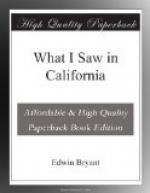Some time in July, a vessel arrived at San Francisco from New York, which had been chartered and freighted principally by a party of Mormon emigrants, numbering between two and three hundred, women and children included. These Mormons are about making a settlement for agricultural purposes on the San Joaquin River, above the rancho of Dr. Marsh. Two of the women and one of the men are now here, waiting for the return of the main party, which has gone up the river to explore and select a suitable site for the settlement. The women are young, neatly dressed, and one of them may be called good-looking. Captain Gant, formerly of the U.S. Army, in very bad health, is also residing here. He has crossed the Rocky Mountains eight times, and, in various trapping excursions, has explored nearly every river between the settlements of the United States and the Pacific Ocean.
The house of Dr. Marsh being fully occupied, we made our beds in a shed, a short distance from it. Suspended from one of the poles forming the frame of this shed was a portion of the carcass of a recently slaughtered beef. The meat was very fat, the muscular portions of it presenting that marbled appearance, produced by a mixture of the fat and lean, so agreeable to the sight and palate of the epicure. The horned cattle of California, which I have thus far seen, are the largest and the handsomest in shape which I ever saw. There is certainly no breed in the United States equalling them in size. They, as well as the horses, subsist entirely on the indigenous grasses, at all seasons of the year; and such are the nutritious qualities of the herbage, that the former are always in condition for slaughtering, and the latter have as much flesh upon them as is desirable, unless (which is often the case) they are kept up at hard work and denied the privilege of eating, or are broken down by hard riding. The varieties of grass are very numerous, and nearly all of them are heavily seeded when ripe, and are equal, if not superior, as food for animals, to corn and oats. The horses are not as large as the breeds of the United States, but in point of symmetrical proportions and in capacity for endurance they are fully equal to our best breeds. The distance we have travelled to-day I estimate at thirty-five miles.
September 17.—The temperature of the mornings is most agreeable, and every other phenomenon accompanying it is correspondingly delightful to the senses. Our breakfast consisted of warm bread, made of unbolted flour, stewed beef, seasoned with chile colorado, a species of red pepper, and frijoles, a dark-coloured bean, with coffee. After breakfast I walked with Dr. Marsh to the summit of a conical hill, about a mile distant from his house, from which the view of the plain on the north, south, and east, and the more broken and mountainous country on the west, is very extensive and picturesque. The hills and the plain are ornamented with the evergreen




